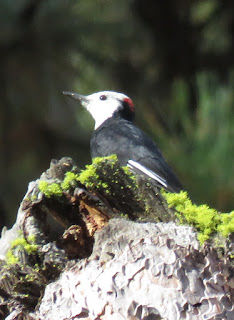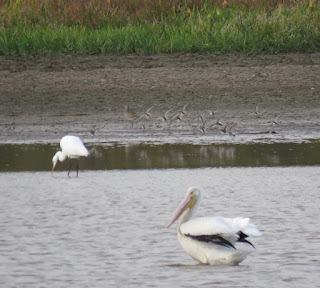-->
I flew from Peru directly to Oregon for my even-numbered-year tour
in late summer. With just one day between tours, it didn’t make sense to fly to
Arizona for just one night, and I enjoyed the chance for a short visit with
friends and my parents.
We started in the Willamette Valley and the Coast Range, where we
saw Sooty Grouse, then went to the coast at Florence for two nights. This Eared
Grebe was an unusual sighting at the north jetty of the Siuslaw River.
Our last morning on the coast featured several banded Snowy
Plovers, and I was able to find out from bander Daniel Farrar some interesting
stories about these individual birds.
Finding a pair of Golden Hairstreaks, Habrodais grunus, courting on their hostplant Golden Chinquapin, Chrysolepis chrysophylla, at Salt Creek
Falls was fun.
We were astounded by the number of Northern Shoveler on the
extensive mudflats of vanishing Lake Abert.
It’s hard to overstate the beauty of eastern Oregon in late
summer, especially Malheur National Wildlife Refuge and Steens Mountain. We saw
plenty of birds, mammals, and other wildlife.
The view from Steens Mountain was amazing, though a bit hazy (but
not nearly as smoky as last year).
As usual, this tour included a day north of Burns to bird the
coniferous forests and aspen-lined creeks. White-headed Woodpecker as a big
target bird, but we covered many likely spots without finding one. Finally on
our last day’s drive back to Portland we made a final stop and lucked into a
pair at the Swick Old Growth Interpretive Trail north of Seneca.
Four of the seven participants joined the pelagic trip extension
out of Newport. This Great Shearwater was a spectacular rarity, Oregon’s third
record. I spotted it first when it flew past the boat at very close range, but
it vanished almost immediately in a huge cloud of California Gulls and
Pink-footed Shearwaters. I thought it might circle around the boat again, but
the boat full of birders kept looking and searching for several minutes without
luck. Only three or four people had managed to get on it at first. Then after
maybe 10 tense minutes, someone decided to look at the only two birds that were
calmly perched on the water right next to the boat – a Black-footed Albatross and
this bird!
Another highlight on the pelagic was the huge number of migrating
Sabine’s Gulls. The official guides estimated over 1500 birds.
I had one day off after the pelagic before flying back to Tucson.
Before turning in the rented tour van I went to Finley National Wildlife Refuge
on my own to chase the first county record of Stilt Sandpiper that had been
found by Pam Otley two days earlier. I saw it and in the process also found a
Whimbrel, very rare inland in Oregon. It was a birdy place, as you can see the
Whimbrel here is surrounded by Western and Least Sandpipers, American White
Pelican, and Great Egret.






















No comments:
Post a Comment